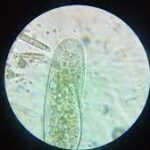In this article, we will see protoctista examples, characteristics of protocista, and types of protocista. In addition, we will look at the protoctista examples too.
Let us see the protoctista examples.
Paramecium caudatum
It is a unicellular protist and belongs to the phylum Ciliophora. Due to the causal tuft in their structure, they are named caudatum. It contains two contractile vacuoles that help excrete excess water from the body.
Forams
Its scientific name stands for foraminifera. It is a unicellular protist that shows similar features to amoebas. Some of their species are considered harmful to human beings due to toxins that can paralyze etc. It is one of the most common protoctista examples.
Sea lettuce
Its scientific name stands for Ulva lactuca. It belongs to the family Ulvaceae. It is an edible source of green algae. It is a common sea vegetable consumed by people of Great Britain, Ireland, China, and Japan.
Marimo
It is also known as Cladophora ball, moss ball, or lake ball. It is a growth of Aegagropila linnaei, which grow in small green balls. It is one of the most common protoctista examples
Giant kelp
The scientific name stands for Macrocystis pyrifera. Another common name, bladder kelp, is also knows it. It belongs to large brown algae under the species of kelp. It is a source of algin and is used in various food and cosmetic industries. It is one of the most common protoctista examples.

Brain-eating amoeba
The scientific name that stands for this species is Naegleria fowleri. It is not considered true algae. This alga infects people with contaminated water, entering the body through the nose.
Euglena viridis
It is a microalga that is present in freshwater. It is a single-celled eukaryote that contains flagella for locomotion. It is used in various labs and is a model organism. It can also cause severe diseases in human beings.
Rhizaria
A single-cell organism is an important component for carbon transport from the surface to the deep sea. It is one of the most common protoctista examples.
Wakame
It is an edible seaweed that has high nutrition value. It is found in cold temperature regions. It is a type of brown seaweed that occur in Asia regions. It is one of the most common protoctista examples.
Radiolaria
It is also known as Radiozoa. It is a protozoan that helps provide carbon dioxide for symbiotic organisms of dinoflagellates.
Irish Moss
the scientific name of this species is Chondrus crispus. It is also known as carrageen moss. It is used in the dairy industry. It is one of the most common protoctista examples.
Entamoeba histolytica
It is an aerobic parasite protozoan that causes a disease called Amebiasis in the intestine of humans and other mammals.
Amoeba proteus
It belongs to the family of amoeba, which resembles giant amoebae. It occurs in the decaying bottom of freshwater grounds. It is one of the most common protoctista examples.
Haptophyte
It is also known as Prymnesiophyta. It is an autotrophic, planktonic unicellular protist that contains flagella for locomotion. They are secondary plastids that show resemblance to the red alga.
Coral Strands
A type of red alga belongs to the family Corallinacea. They form calcium carbonate precipitate in their cell walls and are considered a food supplement with high nutrition value.
Trichomonas vaginalis
It is a protozoan that infects humans and causes the disease Trichomoniasis.
Valonia ventricosa
It is commonly known as bubble algae or sailor’s eyeballs. This species is used for the study of cell membrane permeability.
Plasmodium falciparum
We all know bout this protozoan species, which causes a parasitic disease in humans called Malaria.
Latok
The scientific name stands for Caulerpa lentillifera. It is a green alga found in the coastal region of Indo- Pacific.
Trypanosoma brucei
It is a parasite that causes diseases invertebrate animals and humans. It is one of the most common protocista examples.
Paramecium bursaria
It is marine protoctista examples that has cilia for locomotion. It represents mutualism with green algae called zoochlorella.
Physarum polycephalum
It is an acellular slime mold which is commonly called the blob. It is used to research various cellular components, pathways, etc.
Trypanosoma cruzi
It is a protoctista examples that is coming under parasitic euglenoids. It can cause infection to a human being if they get contacted with infected feces or urines.
Chlamydomonas reinhardtii
It is a green alga which is a single cell protocista. It is widely used for oil production since its cell wall is made up of hydroxyproline-rich glycoproteins.
Plasmodium vivax
It is also a protozoan species that is also a human pathogen. It causes a parasitic disease called Malaria. It is one of the most common protoctista examples.
Paramecium aurelia
It is an important unicellular protocista because it helps in the carbon cycle. They have cilia which help them in feeding and also in locomotion.
Euglena gracilis
It is a freshwater protocista that helps produce proteins, unsaturated fatty acids, wax esters, and paramylon. It is not a harmful organism.
Hijiki
It is algae that are used as brown sea vegetables in Asia. It is rich in fiber and essential minerals and thus considered a good nutritional source of carbon, iron, and magnesium.
Bladderwrack
It is also called Fucus vesiculous. The most common names include- black tang, rockweed, sea grapes, bladder fucus, sea oak, cut weed, dyers fucus, and rock wrack. It is found on the coasts of the North Atlantic and Pacific Oceans.

What is protoctista?
Protoctista or Protista is a kingdom of eukaryotic organisms that are neither animals nor plants. They are unicellular organisms and are found in the colony of cells. Few exceptions of these organisms are found to be multicellular also. They occur in water and damp environment. Sometimes, they are found as parasites too.
They have a diverse collection of organisms. They are eukaryotic organisms that consist of a nucleus and other membrane-bound organelles like- The Golgi apparatus, lysozyme, nuclear envelope, endoplasmic reticulum, etc. Single-celled algae-like amoebas were also classified under the kingdom protocista.
The term protocista means’ the very first”. It is derived from the Greek word ” protists”. They are unicellular organisms and contain membrane-bound organelles; They contain certain structures that help in locomotion. These structures are cilia and flagella. According to scientists’ theory, they are linked to animals and plants. Thus, it forms a link between animals, plants, and fungi. These are derived from a common ancestor like protocista. They contain a nucleus that contains the genetic material. There are photosynthetic protists that have components that help in photosynthesis.
Some protists examples include- diatoms and dinoflagellates. They also contain mitochondria which is a powerhouse of the cell. They get energy from mitochondria to do various functions. They are normally photosynthetic or heterotrophs. The mode of reproduction in protocista is utilizing asexual reproduction. Common asexual reproduction types include binary fission.
Protocista is used in various industries like food, costume, diary, etc. Some of their species have good nutritional values and are consumed as an energy source. Example- Seaweed.

Protoctista characteristics
There are a few characteristics and feature of Protocista, which includes-
Types of Protoctista
They are classified into three types-
Protozoa
Photosynthetic Protists
Slime molds
We will discuss every type in detail.
Protozoa
They are unicellular organisms. They were called “animal” protozoa because they were heterotrophic and represented behavior like animals. They live on different organisms and show parasitic behavior also. They do not have a predefined shape. Example- Amoeba
Examples of Protozoa prtocista are- amoeba, paramecium, and euglenoids. Some species like euglenoids do not depend upon other living organisms for food. They have chlorophyll and can make their food.
It is also divided into four types-
Amoeboid protozoa are found mostly in water. They have false feet called pseudopodia which help in movement and engulfing the food. The protoctista examples- Amoeba.
As the name suggests, Flagellated protozoa occupy flagella for movement and are mostly free-living and parasitic. Example- Euglena.
Ciliated protozoans possess cilia which help in locomotion and nutrition. The protoctista examples- Paramecium.
As the name shows, Sporozoans are protozoa whose life cycle has a stage containing a spore-like structure. The protoctista examples- Plasmodium.
Photosynthetic protest
These types of protists do not depend upon others to prepare food. They have a dominant supply of oxygen. The protoctista examples- Dinoflagellates, chrysophytes, and euglenoids.
Slime moulds
These types of organisms are of multiple color types. They are found in those damp environments. The protoctista examples- Fuligo, dictydium, etc.
Also Read:
- How are nucleotides produced
- Do eukaryotic cells have cytoplasm
- Bacteria cell wall types
- Heterotroph vs autotroph
- Is endocytosis diffusion
- Commensal examples
- Photoautotrophs examples
- Berry fruit examples
- Digestive enzyme example
- Meiosis

Hi…I am Arti Pandey, have a Master’s degree in Biotechnology. I am an academic writer in Lambdageeks and also a beginner Korean learner. I love to explore new cultures, places, and food. I love photography and had a keen interest in creative writing.